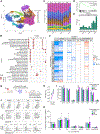Venetoclax plus gilteritinib is effective in preclinical models of FLT3-mutant BCL11B-a lineage-ambiguous leukemia
- PMID: 40811853
- PMCID: PMC12377505
- DOI: 10.1182/blood.2025028985
Venetoclax plus gilteritinib is effective in preclinical models of FLT3-mutant BCL11B-a lineage-ambiguous leukemia
Abstract
Aberrant activation of BCL11B (BCL11B-a) defines a subtype of lineage-ambiguous leukemias with T-lymphoid and myeloid features, co-occurring activating FLT3 mutations, and a stem/progenitor immunophenotype and gene expression profile. Similar to other lineage-ambiguous leukemias, optimal treatment is unclear, and there are limited targeted therapeutic options. Here, we investigated the efficacy of B-cell lymphoma 2 (BCL-2) and FMS-like tyrosine kinase 3 (FLT3) inhibition with venetoclax and gilteritinib, respectively, in preclinical models of BCL11B-a leukemia. Despite variation in response to single-agent therapies, the combination of venetoclax plus gilteritinib (VenGilt) was highly effective in all models evaluated. BH3 profiling suggested that resistance to venetoclax monotherapy was due to the tumor-intrinsic dependence on additional BCL-2 family proteins before drug treatment. Longitudinal single-cell RNA sequencing analysis identified mitochondrial pathways and a pro-lymphoid gene expression signature as potential drivers of rare cell survival on VenGilt therapy. These data support clinical evaluation of venetoclax in combination with gilteritinib in BCL11B-a lineage-ambiguous leukemias.
© 2025 American Society of Hematology. Published by Elsevier Inc. All rights are reserved, including those for text and data mining, AI training, and similar technologies.
Figures



Comment in
-
Double trouble for a blurry foe: precision strike on BCL11B.Blood. 2025 Nov 6;146(19):2280-2281. doi: 10.1182/blood.2025030748. Blood. 2025. PMID: 41196623 No abstract available.
References
-
- Choi JK, Xiao W, Chen X, et al. Fifth Edition of the World Health Organization Classification of Tumors of the Hematopoietic and Lymphoid Tissues: Acute Lymphoblastic Leukemias, Mixed-Phenotype Acute Leukemias, Myeloid/Lymphoid Neoplasms With Eosinophilia, Dendritic/Histiocytic Neoplasms, and Genetic Tumor Syndromes. Modern Pathology. 2024;37(5):100466. - PubMed
MeSH terms
Substances
Grants and funding
LinkOut - more resources
Full Text Sources
Medical
Miscellaneous

